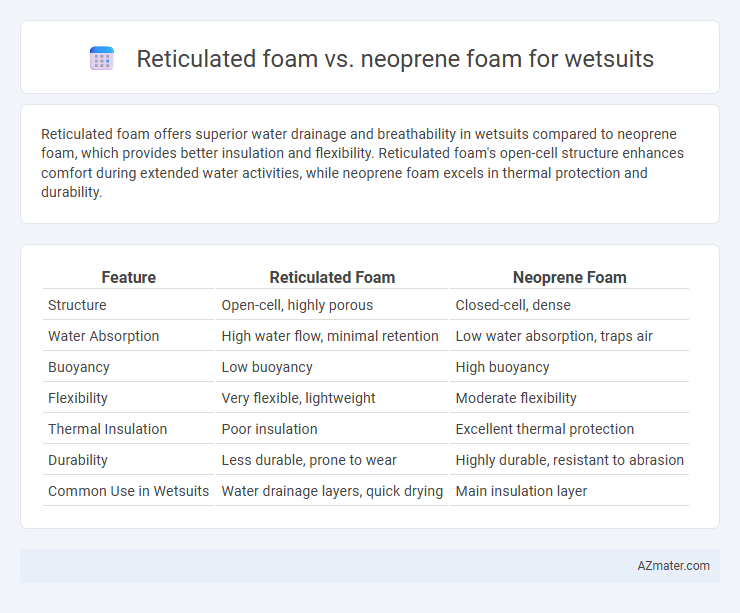Reticulated foam offers superior water drainage and breathability in wetsuits compared to neoprene foam, which provides better insulation and flexibility. Reticulated foam's open-cell structure enhances comfort during extended water activities, while neoprene foam excels in thermal protection and durability.
Table of Comparison
| Feature | Reticulated Foam | Neoprene Foam |
|---|---|---|
| Structure | Open-cell, highly porous | Closed-cell, dense |
| Water Absorption | High water flow, minimal retention | Low water absorption, traps air |
| Buoyancy | Low buoyancy | High buoyancy |
| Flexibility | Very flexible, lightweight | Moderate flexibility |
| Thermal Insulation | Poor insulation | Excellent thermal protection |
| Durability | Less durable, prone to wear | Highly durable, resistant to abrasion |
| Common Use in Wetsuits | Water drainage layers, quick drying | Main insulation layer |
Introduction to Wetsuit Foams
Reticulated foam and neoprene foam are two primary materials used in wetsuit construction, each offering distinct benefits for thermal insulation and flexibility. Reticulated foam is highly breathable and features an open-cell structure allowing water to flow through, making it suitable for warmer water activities where quick drying is essential. Neoprene foam, on the other hand, boasts closed-cell bubbles that trap air, providing superior insulation and buoyancy ideal for colder water diving and surfing conditions.
What is Reticulated Foam?
Reticulated foam is a highly porous material characterized by a skeleton-like structure, allowing maximum water flow and rapid drainage, which makes it ideal for wetsuits where breathability and quick drying are essential. Unlike neoprene foam, reticulated foam lacks closed cells and provides superior water permeability, enhancing comfort and flexibility during water sports. This foam's open-cell construction improves thermal regulation while maintaining lightweight durability, making it a preferred choice for wetsuit components requiring high ventilation.
What is Neoprene Foam?
Neoprene foam is a synthetic rubber material widely used in wetsuits for its excellent insulation and flexibility. It consists of closed-cell foam with tiny nitrogen gas bubbles that reduce heat transfer, keeping divers warm in cold water. Reticulated foam, in contrast, features an open-cell structure that allows water flow, making neoprene the preferred choice for thermal protection in wetsuits.
Key Material Differences
Reticulated foam is characterized by its open-cell structure, allowing for superior water drainage and enhanced breathability, making it ideal for wetsuits designed for warmth and flexibility. Neoprene foam features a closed-cell construction that provides excellent insulation and buoyancy by trapping air bubbles, offering better thermal protection in cold water conditions. The key material difference lies in reticulated foam's porous network for quick drying, whereas neoprene's dense matrix ensures durability and insulation.
Water Absorption and Drainage
Reticulated foam offers superior water drainage due to its open-cell structure, allowing water to flow through quickly and reducing water absorption in wetsuits. Neoprene foam, characterized by its closed-cell composition, absorbs less water initially but retains moisture longer, providing better insulation but slower drainage. Choosing between reticulated foam and neoprene foam depends on prioritizing rapid water expulsion or thermal insulation in wetsuit performance.
Insulation and Thermal Properties
Reticulated foam, characterized by its open-cell structure, offers excellent breathability but less insulation due to rapid water drainage, making it less effective for thermal retention in wetsuits. Neoprene foam features a closed-cell structure that traps nitrogen gas, providing superior insulation and thermal properties by minimizing heat loss and maintaining body warmth in cold water conditions. The choice between reticulated and neoprene foam impacts wetsuit performance, with neoprene foam preferred for colder environments requiring enhanced thermal protection.
Flexibility and Comfort
Reticulated foam offers superior breathability and flexibility due to its highly porous structure, making it ideal for wetsuits that require enhanced movement and quick water drainage. Neoprene foam provides excellent thermal insulation and cushioning, delivering comfort through its dense, closed-cell composition that retains warmth effectively. Choosing between reticulated and neoprene foam depends on the balance needed between flexibility for active water sports and comfort through thermal protection.
Durability and Longevity
Reticulated foam offers superior durability for wetsuits due to its open-cell structure that allows for faster drying and better resistance to compression over time, enhancing longevity in harsh marine environments. Neoprene foam, while providing excellent insulation and flexibility, tends to degrade faster when exposed to UV rays, saltwater, and repeated flexing, reducing its lifespan compared to reticulated foam. Choosing reticulated foam ensures a more robust wetsuit that withstands wear and tear longer, making it ideal for frequent divers or surfers seeking long-term performance.
Environmental Impact and Sustainability
Reticulated foam, made from polyurethane, is highly porous and offers excellent water drainage, but it is less biodegradable and derived from non-renewable petroleum resources, contributing to environmental pollution. Neoprene foam, traditionally produced from petroleum-based chemicals, poses significant environmental challenges due to its non-biodegradability and energy-intensive manufacturing process; however, recent advancements include plant-based and limestone-based neoprene alternatives that reduce carbon footprint and improve sustainability. Choosing wetsuits with natural rubber blends, recyclable materials, or low-impact manufacturing processes helps minimize ecological damage and supports marine ecosystem preservation.
Choosing the Right Foam for Your Wetsuit
Reticulated foam offers superior water drainage and breathability for wetsuits, making it ideal for warm-water activities, while neoprene foam provides excellent insulation and flexibility, essential for thermal protection in cold conditions. Choosing the right foam depends on water temperature, activity type, and desired durability, with reticulated foam favoring ventilation and neoprene emphasizing warmth and comfort. Consider factors such as buoyancy, thickness, and resistance to wear to ensure optimal performance and longevity in your wetsuit material.

Infographic: Reticulated foam vs Neoprene foam for Wetsuit
 azmater.com
azmater.com